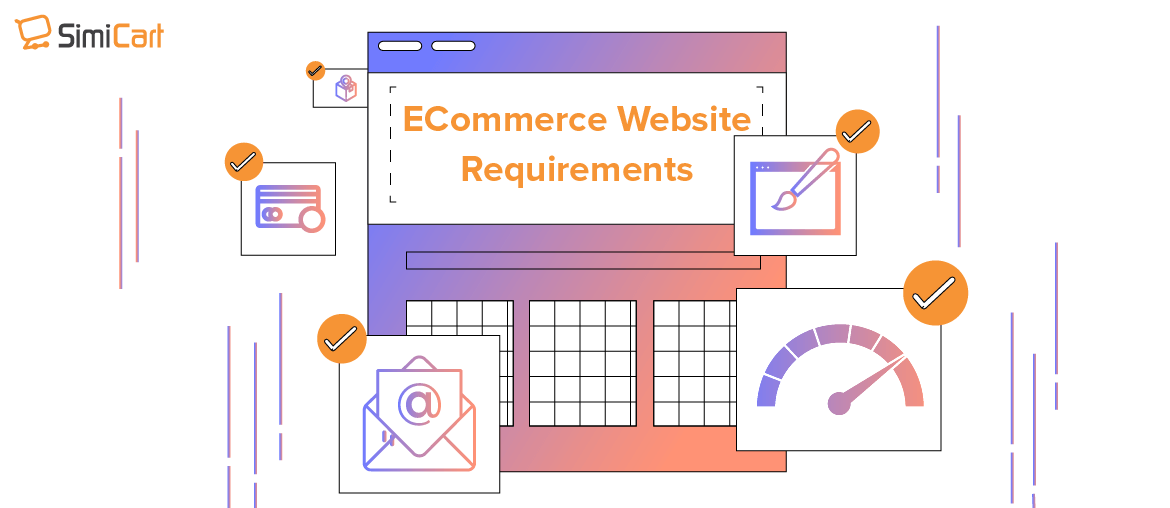Table of contents
Want to start an online business? It’s never been easier thanks to the wide availability of tools and resources for eCommerce owners on the internet, it’s never been easier. On the other hand, competition in online sales has never been more fierce. Only those with knowledge, patience, and experience know how to win.
This article explores the most essential eCommerce website requirements in 2023. As a result, you can focus only on the important factors for success and build a brilliant digital store.
eCommerce website requirements checklist
1. Fast, stable & secure web hosting
In order to publish your eCommerce website, you need a web hosting service. Web hosting offers any facilities required to launch, store and maintain websites on the internet.
It also takes care of your website’s speed, uptime, and security, which are important for any eCommerce store. We will get into each factor now.
Security
As cyber security remains a top concern for all internet users, customers need to feel safe before filling in their cards and other valuable personal information for checkout purposes.

Moreover, web browsers warn their users whenever they enter a site with no SSL certificate – shown by the subdomain “HTTP.” This alone can scare people away from your online store.
A secured website is also packed with benefits on the store owners’ end. It can protect them from cyberattacks, data stealing, and other unwanted risks.
Stability
If your store shuts down unexpectedly when your customers are buying, you will lose lots of sales and even a reputation. For eCommerce, it’s crucial for digital stores to be live all the time unless it’s on maintenance.

In fact, generally, uptime – when your store is accessible online – needs to be at least 99%, while downtime – time for maintenance, system errors, etc. – has to be less than 1%.
Speed
Over a decade ago, Amazon discovered that every extra 100ms in loading time costs 1% of their sales. The insight is still relevant today. That’s why giant sites like Amazon, Google, Netflix, Facebook, etc., are super fast-loading.
Customers are so used to these speedy experiences that they expect every other site to be the same. Google suggests that no web page should load more than 2 seconds, and it has been the goal for all eCommerce stores.
Whereas speed performance depends on your website’s size and technical structure, web hosting also plays a crucial role. Hosting plans with better bandwidth and CDN functions result in faster web pages.
Thus, understanding eCommerce hosting and choosing a suitable service will solve many security, performance, and stability issues.
If you don’t want to think much about these technical matters, you can choose a SaaS (Software-as-a-Service) platform like Shopify or BigCommerce. These platforms will take care of everything related to hosting so that you can focus more on sales and products.
>> Read more:
2. Highly-responsive mobile site

Responsiveness means that your online store can adapt to many different screen sizes, which is essential for a seamless customer experience.
According to Shopify, 71% of 2021’s Black Friday Cyber Monday sales were made via mobile, while desktop sales only accounted for 29%.
Also, in the US only, the number of mobile shoppers is expected to reach 187 million by 2024.
It’s no surprise that mobile is the top sale channel for all eCommerce stores, and optimizing mobile sites for seamless customer experience is a must.
Store owners need to pay attention to details to ensure that their mobile web pages are perfect. For example, enlarging call-to-action buttons for easy fingertip touches or adjusting text banners to be fully visible on smartphones.
Besides, upgrading to the PWA (Progressive Web App) can significantly enhance mobile loading pages, enable offline shopping and web push notifications. Thus, PWA is another great way to leverage the mobile experience as well.
Last but not least, a smooth native app has great power to engage with your customers and maximize your revenues via smartphones. Have lots of SKUs and want to build a community of loyal frequent buyers? A mobile app may be the answer.
And the Siminia Theme is the perfect solution to enhance the mobile experience of your eCommerce store.
Based on PWA Studio, Siminia Theme is an easy way to transform your store into a headless storefront that is fast, engaging, and mobile-friendly. It can optimize mobile performance and create an app-like UX for your website.
CLICK HERE to install Siminia Theme to your Magento store for free!
>> Read more:
3. User-friendly web design

UI/UX design catches your customers’ attention the moment they land on your site while showcasing your items and brand characteristics in the best light.
You may want to do many creative things with your stores. However, remember that the most important factor for eCommerce website design is user-friendliness.
Before getting into details, here’re some stats that speak
- 42% of visitors leave a website due to its poor functionality
- 38.5% of web designers think outdated design is the culprit of a high website-exit rate
- 22% of websites’ first-time visitors are captivated by eye-catching colors. On the other hand, if the colors are too outlandish, 21% will leave.
- For the first time browsing a website, 38% of visitors will try to understand the web layouts and find navigational links.
(credit/ Hubspot)
People are leaving because these websites do not seem effortless for them, nor do they manage to respond to their requirements.
User-friendly designs help visitors easily navigate, browse products, look for information and checkout. Besides, it also engages them with satisfying visual presentations.
For a modern eCommerce website, it’s important to:
- Have a clean design that is not complicated to look at
- Use eye-flattering colors that are not too boring and too unfamiliar at the same time.
- Clear layouts that are not confusing to figure out its functions & an easy-to-find navigation menu.
>> Read more
4. Robust operation systems

Reliable management systems for inventory and order save you lots of time on manual tasks and let you confidently run a digital store.
As for inventory, for example, your eCommerce website’s backend can manage stocks and multiple warehouses, batch import catalogs & customer information, calculate tax rate per location, alert low-stock products, etc.
All popular eCommerce platforms such as Magento, Shopify, or Wix have robust inventory & order management functions, though their offered functions may differ.
All popular eCommerce platforms such as Magento, Shopify, or Wix have robust functions for inventory & order management, though their offered functions may differ from each other.
If you plan to have multiple online stores to operate at once, Magento may be a great choice.
If you plan to dropship or start a P.O.D business, Shopify, with plenty of supporting extensions & low beginning costs, seems to be more suitable.
Related articles:
5. Fast checkout process
Seven out of every ten customers leave their cart abandoned. This means that 70% of customers do not complete the transaction for what they intended to buy.
One of the most prominent reasons is the complicated checkout process.
Lots of buying decisions are impulsive. Consumers buy when they are in the mood for it. Lengthy checkout, meanwhile, destroys their patience and motivation to buy.

A smooth checkout enables payments to be made in no time while customers are still excited to buy, thus, maximizing sales potential.
For an eCommerce website, here are some essential things to be done for checkout pages.
- Consider social login for customers who are lazy to create an account
- Use one-page checkout instead of a multi-step checkout

- Show transparent, real-time shipping fees and avoid adding hidden costs
- Integrate with common payment gateways in your country
6. Transparent brand information pages

For an eCommerce website, the homepage, category pages, and product pages are the most important – they boast about your products’ awesomeness.
However, it’s crucial not to ignore other information pages, such as:
- About Us
- FAQ
- Terms & Policy
- Size Guide
- Contact Us
- Return Policy
Each of the pages has its own purpose. While the About Us page lets you express your brand characteristics and inspire your customers to buy, the Return Policy gives them an exact idea of what to expect if they want to return & avoids unwanted disputes.
However, in general, these pages provide customers with useful information that can affect their buying decisions, show how thoughtful you are & increase your store’s reputation.
Therefore, make sure you write captivating and useful information pages
>> Read more: How to write an eCommerce returns policy?
7. SEO-friendly web pages
SEO (search engine optimization) is the practice of getting your eCommerce website found on search engines like Google and Bing.

Just like how any sausage vendor would want their trucks to be in the most crowded places for many people to see, you would want your eCommerce store to appear on the first result pages of search engines for the most website traffic.
Apparently, you do not need to show up on EVERY search results page, but it would be ideal if your website appeared in the results list for search queries specific to your products.
A study in 2019 found that 52.3% of all website traffic comes from organic search results and 68% of online experiences start with search engines.
Since search engines like Google are reliable sources for buyers to find and research products, an SEO-friendly eCommerce website can attract many potential customers.
Guess what’s better? SEO requires very little or even no cost.
In order to do that, you must learn different criteria to get ranked well on search engines, adjust your website content, and do some technical customization accordingly.
>> Read more: Best eCommerce SEO practice for beginners
8. Smooth sales channels integration
Connecting your online website with your brick-and-mortar stores unifies inventory & order data as well as leverages customer experience.
For example, while shopping in a physical store, buyers can scan QR codes to browse product information on thone store’s online sites & use vouchers sent in their emails to purchase.
Besides, from social media like Facebook, Instagram to marketplaces like Amazon, expanding your sales channels increases your chances of getting found online, which means more revenue.
Many Shopify stores that are successful with their unique product lines integrate with Amazon to reach more potential customers. Moreover, using Instagram ads to drive users to eCommerce sites is also a common tactic to increase sales.

Omnichannel experiences like these improve customer satisfaction, foster brand loyalty, streamline operation, unify data sources and boost sales.
Plus, ever since the pandemic, consumers have shifted to buying online. The trend is expected to last even after Covid-19 when consumers take advantage of both digital and physical shopping.
9. Product reviews

Besides price consideration, customers also have many doubts before buying products from a brand they haven’t purchased before. It’s especially true if you sell high-value products like electric goods or furniture.
Product reviews are by far the most convincing way to break this barrier and boost new customers’ buying confidence. People purposely turn to reviews to find trust and information. On the other hand, if a site has little or no reviews, they will question the brand’s reliability and, in many cases, end up not buying.
For this reason, any eCommerce newbie should make a good effort to collect reviews & testimonials.
10. Personalized product recommendations

Instead of showing random product recommendations, the personalization practice is based on various sources of data like customer browsing history and your site’s real-time bestsellers to promote products. These suggestions are more relevant to the specific needs of each customer, which increases the chance of sales.
It has been proven to be an effective upsell & cross-sell tactic. In fact, 35% of Amazon’s revenues come from personalized recommendations alone.
>> Read more: Personalization Product Recommendation – Best examples
11. Low shipping fee

It’s common for giant eCommerce websites like Amazon, Alibaba to take advantage of their advanced fulfillment systems to offer free shipping. The bad thing is, consumers are so accustomed to getting freeship that they take it quite seriously. 61% of customers are “somewhat likely” to stop buying if there is no free-delivery offer.
On the other hand, small businesses with limited budgets can not offer free shipping the way the big guys do. The challenge is to make it as affordable as possible, while still maintaining shipping quality.
Here are some suggestions:
- Offer free shipping if customers’ order values reach a certain threshold
- Increase inventories across locations to reduce the shipping distances
- Since shipping cost depends on your packages’ sizes and weights, check order history to see how many products you often send at once & figure out the most common package size of your orders. This will help you find the type of shipping boxes that best fit your brand’s products in general.
12. Integration with a digital advertising service

Most eCommerce brands rely on some paid services (i.e Facebook Ads, Google Ads, etc) to drive more potential customers to their digital stores.
Whereas organic content marketing efforts like SEO or blogs take time to grow (at least 6 months before you’re gonna see any noticeable benefits from it), advertisements offer a faster way to get exposed to your audiences and generate sales.
Connecting your eCommerce store with an ad tool is a must for it to gather your customers’ on-site data, learn & deliver better-targeted ads.
However, digital advertising can be pretty costly, and if newbie eCommerce owners do not know how to run effective ads campaigns, they’re gonna waste lots of money without any benefits.
It’s difficult to drive dramatic sales with low ad costs for beginners. Therefore, lots of eCommerce brands do not aim at conversions when they start rolling. Instead, they focus on experimenting ads platforms and use them to better understand their market and consumers. Once they get what works and what does not, it’s easier to run campaigns that convert.
13. Integration with an email marketing tool

Besides acquiring new customers, nurturing your existing customers and turning them into frequent buyers should be a priority for every eCommerce brand.
While it may take lots of effort, from ads to promotions to product reviews, to get people to buy the first time, it’s easier to encourage them to buy again once they’ve loved your products and services already.
Sending eCommerce emails with personalized product recommendations, promotion notifications, and other engaging content builds customer relationships & converts perfectly.
Statistically speaking, with every $1 spent on email marketing, you get $37 in revenue. Generally, expert eCommerce marketers expect email marketing to generate at least 30% of the brand’s revenue.
Integrating your eCommerce website with an email marketing tool is the first step. Also, you may need some creative popups for your website to collect a decent list of customer emails to get started with.
>> See more: eCommerce personalized emails
14. Blogs

Blog is an effective content marketing channel to attract new visitors and turn them into loyal buyers. It helps increase SEO visibility significantly, which means more customers will find your eCommerce site.
Also, by providing useful tips, reviews, instructions & entertaining content for your users, you can keep customers coming back to your website and build brand loyalty.
Building a useful blog can take time and effort, but it can be totally free. A blog is a great way to build up a successful eCommerce website from scratch with only knowledge and creativity needed. It’s particularly true for small businesses when investing in ads or other paid marketing tools can cost greatly.
15. Report + Analytics tool
Reports are essential to measure how your website performs to decide the next action.
Besides revenues and the number of products sold, there are other metrics worth knowing. For example, sales conversion rate, website traffic, email opt-in rate, average customer value and cart abandonment rate.
Any popular eCommerce platform that you may use can provide some sort of analytics and data. For instance, Magento features reports for sales, taxes, abandoned carts, most viewed products, and more.
Of all analytics tools, Google Analytics is the most common. Google Analytics helps measure SEO performance, understand different sources of customers, your best-viewed web pages, and more.
As your business grows, you can integrate with more data tools to take advantage of AI and big data analytics for a deeper dive into your customer insights.
Over to you!
These are the basic requirements to start a successful eCommerce website in 2023. We have weighed up and down many factors to consolidate the list. Hope it helps you gain some great insights for your eCommerce plan.
Lots of them are included in package plans offered by popular eCommerce platforms.
>> Also find:




